The SSD Relapse: Understanding and Choosing the Best SSD
by Anand Lal Shimpi on August 30, 2009 12:00 AM EST- Posted in
- Storage
Intel's X25-M 34nm vs 50nm: Not as Straight Forward As You'd Think
It took me a while to understand exactly what Intel did with its latest drive, mostly because there are no docs publicly available on either the flash used in the drives or on the controller itself. Intel is always purposefully vague about important details, leaving everything up to clever phrasing of questions and guesswork with tests and numbers before you truly uncover what's going on. But after weeks with the drive, I think I've got it.
| X25-M Gen 1 | X25-M Gen 2 | |
| Flash Manufacturing Process | 50nm | 34nm |
| Flash Read Latency | 85 µs | 65 µs |
| Flash Write Latency | 115 µs | 85 µs |
| Random 4KB Reads | Up to 35K IOPS | Up to 35K IOPS |
| Random 4KB Writes | Up to 3.3K IOPS | Up to 6.6K IOPS (80GB) Up to 8.6K IOPS (160GB) |
| Sequential Read | Up to 250MB/s | Up to 250MB/s |
| Sequential Write | Up to 70MB/s | Up to 70MB/s |
| Halogen-free | No | Yes |
| Introductory Price | $345 (80GB) $600 - $700 (160GB) | $225 (80GB) $440 (160GB) |
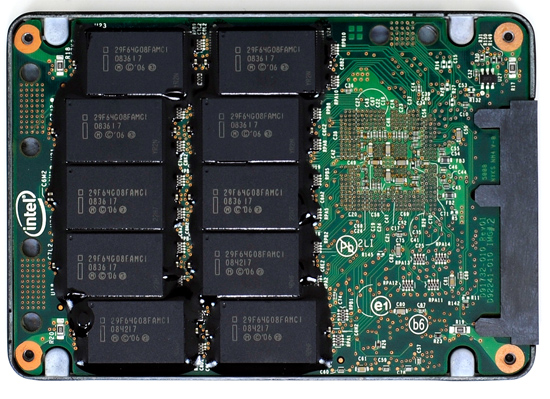
The old X25-M G1
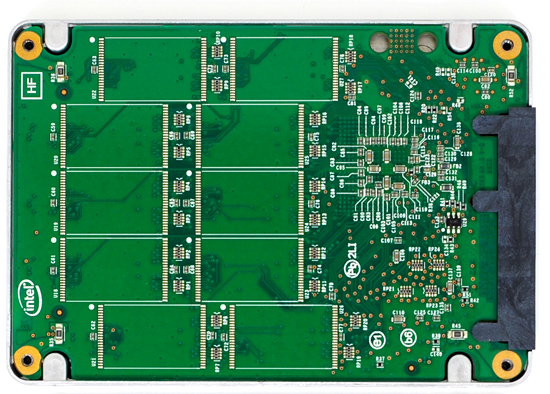
The new X25-M G2
Moving to 34nm flash let Intel drive the price of the X25-M to ultra competitive levels. It also gave Intel the opportunity to tune controller performance a bit. The architecture of the controller hasn't changed, but it is technically a different piece of silicon (that happens to be Halogen-free). What has changed is the firmware itself.

The old controller

The new controller
The new X25-M G2 has twice as much DRAM on-board as the previous drive. The old 160GB drive used a 16MB Samsung 166MHz SDRAM (CAS3):
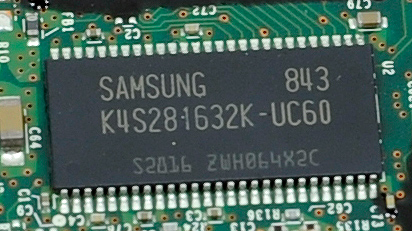
Goodbye Samsung
The new 160GB G2 drive uses a 32MB Micron 133MHz SDRAM (CAS3):
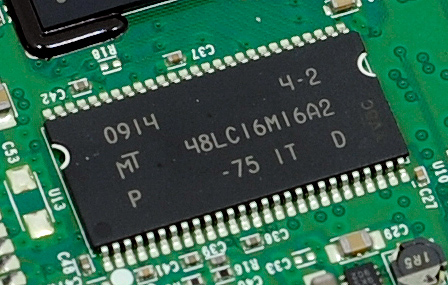
Hello Micron
More memory means that the drive can track more data and do a better job of keeping itself defragmented and well organized. We see this reflected in the "used" 4KB random write performance, which is around 50% higher than the previous drive.
Intel is now using 16GB flash packages instead of 8GB packages from the original drive. Once 34nm production really ramps up, Intel could outfit the back of the PCB with 10 more chips and deliver a 320GB drive. I wouldn't expect that anytime soon though.
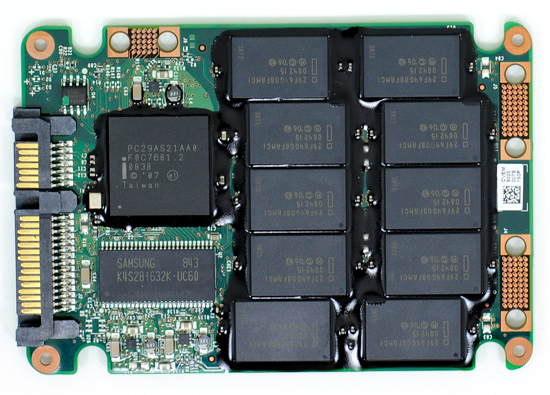
The old X25-M G1
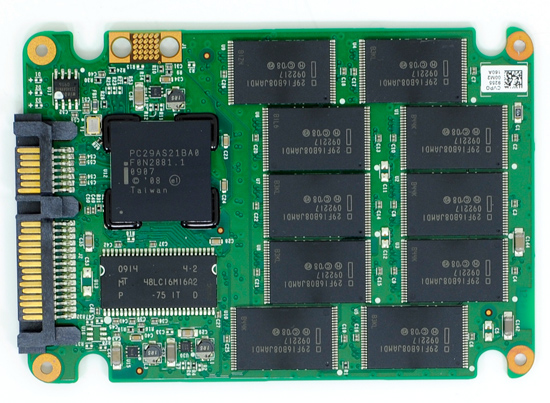
The new X25-M G2
Low level performance of the new drive ranges from no improvement to significant depending on the test:
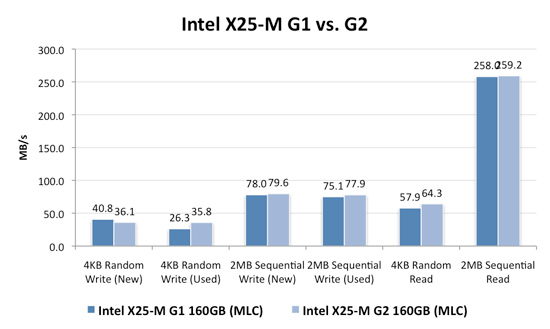
Note that these results are a bit different than my initial preview. I'm using the latest build of Iometer this time around, instead of the latest version from iometer.org. It does a better job filling the drives and produces more reliable test data in general.
The trend however is clear: the new G2 drive isn't that much faster. In fact, the G2 is slower than the G1 in my 4KB random write test when the drive is brand new. The benefit however is that the G2 doesn't drop in performance when used...at all. Yep, you read that right. In the most strenuous case for any SSD, the new G2 doesn't even break a sweat. That's...just...awesome.
The rest of the numbers are pretty much even, with the exception of 4KB random reads where the G2 is roughly 11% faster.
I continue to turn to PCMark Vantage as the closest indication to real world performance I can get for these SSDs, and it echoes my earlier sentiments:
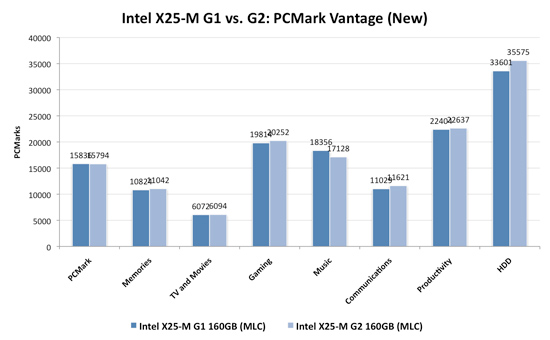
When brand new, the G1 and the G2 are very close in performance. There are some tests where the G2 is faster, others where the G1 is faster. The HDD suite shows the true potential of the G2 and even there we're only looking at a 5.6% performance gain.

It's in the used state that we see the G2 pull ahead a bit more, but still not drastic. The advantage in the HDD suite is around 7.5%, but the rest of the tests are very close. Obviously the major draw to the 34nm drives is their price, but that can't be all there is to it...can it?
The new drives come with TRIM support, albeit not out of the box. Sometime in Q4 of this year, Intel will offer a downloadable firmware that enables TRIM on only the 34nm drives. TRIM on these drives will perform much like TRIM does on the OCZ drives using Indilinx' manual TRIM tool - in other words, restoring performance to almost new.
Because it can more or less rely on being able to TRIM invalid data, the G2 firmware is noticeably different from what's used in the G1. In fact, if we slightly modify the way I tested in the Anthology I can actually get the G1 to outperform the G2 even in PCMark Vantage. In the Anthology, to test the used state of a drive I would first fill the drive then restore my test image onto it. The restore process helped to fragment the drive and make sure the spare-area got some use as well. If we take the same approach but instead of imaging the drive we perform a clean Windows install on it, we end up with a much more fragmented state; it's not a situation you should ever encounter since a fresh install of Windows should be performed on a clean, secure erased drive, but it does give me an excellent way to show exactly what I'm talking about with the G2:
| PCMark Vantage (New) | PCMark Vantage HDD (New) | PCMark Vantage (Fragmented + Used) | PCMark Vantage HDD (Fragmented + Used) | |
| Intel X25-M G1 | 15496 | 32365 | 14921 | 26271 |
| Intel X25-M G2 | 15925 | 33166 | 14622 | 24567 |
| G2 Advantage | 2.8% | 2.5% | -2.0% | -6.5% |
Something definitely changed with the way the G2 handles fragmentation, it doesn't deal with it as elegantly as the G1 did. I don't believe this is a step backwards though, Intel is clearly counting on TRIM to keep the drive from ever getting to the point that the G1 could get to. The tradeoff is most definitely performance and probably responsible for the G2's ability to maintain very high random write speeds even while used. I should mention that even without TRIM it's unlikely that the G2 will get to this performance state where it's actually slower than the G1; the test just helps to highlight that there are significant differences between the drives.
Overall the G2 is the better drive but it's support for TRIM that will ultimately ensure that. The G1 will degrade in performance over time, the G2 will only lose performance as you fill it with real data. I wonder what else Intel has decided to add to the new firmware...
I hate to say it but this is another example of Intel only delivering what it needs to in order to succeed. There's nothing that keeps the G1 from also having TRIM other than Intel being unwilling to invest the development time to make it happen. I'd be willing to assume that Intel already has TRIM working on the G1 internally and it simply chose not to validate the firmware for public release (an admittedly long process). But from Intel's perspective, why bother?
Even the G1, in its used state, is faster than the fastest Indilinx drive. In 4KB random writes the G1 is even faster than an SLC Indilinx drive. Intel doesn't need to touch the G1, the only thing faster than it is the G2. Still, I do wish that Intel would be generous to its loyal customers that shelled out $600 for the first X25-M. It just seems like the right thing to do. Sigh.










295 Comments
View All Comments
kisjoink - Monday, August 31, 2009 - link
"Intel doesn't need to touch the G1, the only thing faster than it is the G2."I've been an avid anandtech-reader since 1998, but this is the first time I'm commenting on an article. I just have to say how much I disagree with this quote!
I've used the x25m since its launch (December 08) and at first I was very happy with the drive. Although really expensive, I got convinced to buy one after reading your first previews and review. And the performance was great, at least for the first 4-5 months. At that time I started noticing some 'hiccups' (system freeze). At first they were few and short. But over time they become more noticeable and now they're a real pain. Sometimes my system can freeze for more than 15 seconds. It usually happens when I edit a picture in photoshop, but it can also happen while writing something in Word, programming java in Eclipse or just surfing the web.
The problem? I'm pretty sure its the Intel drive. After reading too many SSD-articles I immediately suspected the x25m when the I started noticing the hiccups. So I got used to running the "Windows Resource Monitor" in the background - studying the disk activity after every hiccup. Just take a look at this example (just started photoshop and did some light editing on a picture):
http://img256.imageshack.us/img256/3073/hickup.jpg">http://img256.imageshack.us/img256/3073/hickup.jpg
I'm sure there are many ways I could tune my system better. I've done a couple of things, like moved the internet temp folder to a mechanical drive etc. And the performance of the drive will probably recover if I do this special SSD-format - but it's a real pain to have to do complete OS installation 2-3 times a year when you claim it's possible for Intel to create a new firmware with TRIM-support. I mean - I really did pay premium price for this product (close to 800$ included VAT here in Norway for the 80GB version in December 08).
So, to summarise - I got convinced to buy the drive after reading your articles (you write great reviews!) - and I understand that the problem that I (and others from what I've been reading on forums) is really difficult to recreate in a testing environment - but that doesn't mean that the problem doesn't exist. I just wish you could point this out. The expensive G1 has some really big performance issues that might force you to do a complete reinstall of your system a couple times a year - and although Intel could fix it they wont, because they have a new, better and cheaper product out - and people like me (altough we feel really screwed over by Intel) will buy their next device (as long as its the best device out there).
IntelUser2000 - Monday, August 31, 2009 - link
Is that after you installed the firmware version 8820 or before?? That reduces the problem a lot unless you filled the drive to more than 70%.kisjoink - Monday, August 31, 2009 - link
Yes, I forgot to mention that - it's after I upgraded to the 8820 firmware. I don't think I've ever filled it up with more than 80%, usually I have about 30GB of free spaceAnand Lal Shimpi - Monday, August 31, 2009 - link
This is actually an interesting scenario that I've been investigating a bit myself. The 8820 firmware actually significantly changes the way the drive likes to store data compared to the original firmware. That's fine for a cleanly secure-erased drive, but what happens if you have data/fragmentation on the drive already?Every time you write to the drive the controller will look at the preferred state specified by the new firmware. It will see that your data is organized the way the old firmware liked it, but not the new firmware. Thus upon every...single...write it will try and reorganize the data until it gets to its happy state.
I honestly have no idea how long this process will take, I can see it taking quite a bit of time but perhaps you could speed it up by writing a bunch of sequential files to fill up the drive? The safer bet would be to backup, secure erase and restore onto the drive. You shouldn't see it happen again.
Think of it like this. I live in my house and I have everything organized a certain way. It takes me minimal time to find everything I need. Let's say tomorrow I leave my house and you move in. You look at how things are organized and it's quite different from how you like things setup. Whenever you go to grab a plate or book you try cleaning up a bit. Naturally it'll take a while before things get cleaned up and until then you won't be as quick as you're used to.
Take care,
Anand
jimhsu - Friday, September 11, 2009 - link
The G2's I've discovered REALLY don't like to be filled up more than 80% or so. When I had 8GB free on the 80GB drive, seq write performance basically plummeted at random intervals (to levels like 30MB/s.) Random writes sometimes dropped down to 4MB/s. Now that I've freed 20GB and tried writing and deleting large ISO files to the drive, the performance is coming back slowly.Dunk - Monday, August 31, 2009 - link
Hi Anand,I'm blown away by your article series on SSD - absolutely fantastic.
When new Intel firmware is launched with TRIM support for the G2, can I flash it without losing the drive and needing to reinstall everything?
I'm happy using the out of the box MS driver for now in Win7, but would prefer to use Intel's TRIM version once available.
Many thanks
Duncan
Anand Lal Shimpi - Monday, August 31, 2009 - link
If Intel follows the same pattern as what we saw with the G1's firmware update, you should be able to flash without destroying your data (although it's always a good idea to back up).Thank you for your comment :)
Take care,
Anand
mgrmgr - Monday, August 31, 2009 - link
Okay, single X25-M G2s can be updated without losing data. But I am considering two 80GB drives in RAID-0 to overcome the sequential write slowdown with Photoshop. How will updating work for the RAID-0 pair?Do you have an opinion about using a RAID pair for Photoshop?
Noteleet - Monday, August 31, 2009 - link
Fantastic article, I'm definitely planning on getting a SSD next time I upgrade.I'm fairly interested in seeing some reviews for the Solid 2. If OCZ can get the kinks worked out I think the Intel flash and the Indilinx controller would make a winning combination for price to performance.
Visual - Monday, August 31, 2009 - link
Where does the drive store the mapping between logical and physical pages and other system data it needs to operate? Does it use the same memory where user data is stored? If so, doesn't it need to write-balance that map data as well? And if that's true, doesn't it need to have a map for the map written somewhere? How is that circular logic broken?Or does the drive have some small amount of higher-quality, more reliable, maybe single-level-cell based flash memory for its system data?